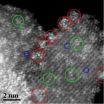Some vaccines under study are designed to activate a specific molecule that is an early participant in the immune response against TB in young people. But a recent Ohio State University study suggests that in older people, this molecule remains relatively inactive, even in the face of TB infection.
The animal research suggests that the presence of this molecule, called a toll-like receptor, is not required in an old mouse to generate an immune response to Mycobacterium tuberculosis, the pathogen that causes TB infection. The immune response in young mice without the receptor, however, is not robust enough to adequately fight TB infection.
So while young people would stand to benefit from a vaccine that boosts this molecule's function, it appears a new direction in vaccine research is needed to ensure that the elderly also receive protection against the disease, researchers say.
One caveat, says Joanne Turner, associate professor of internal medicine at Ohio State and lead author of the paper, is that this finding occurred in mice that are completely lacking the receptor in question.
"If old mice have this receptor on the surface of their cells, it probably functions, but not as well as it should, and not as well as it does when mice are younger," Turner said. "When we take it away, something else works on its behalf. Our next step will be to find which receptor is responsible in old mice for sending the immune response signals, because that should be the focus of a vaccine for the elderly."
The study is published in a recent issue of the journal Mechanisms of Aging and Development.
About 2 billion people worldwide are thought to be infected with Mycobacterium tuberculosis. People can harbor the bacterium without symptoms for decades, but an estimated one in 10 will develop active disease characterized by a chronic cough and chest pain. The elderly are considered highly susceptible to both reactivation of latent infection and newly acquired infections, especially in long-term care facilities. Many older patients cannot tolerate the months-long antibiotic regimen required to treat active TB.
Despite that higher infection susceptibility, researchers still do not know exactly what happens during aging that either weakens the immune response or otherwise reduces elderly people's ability to fight infection.
Turner and colleagues focused this work on the molecule known as TLR-2, or toll-like receptor-2. It is among the receptors located on the surface of macrophages, which are the first cells in the lungs to see Mycobacterium tuberculosis at the point of infection.
The job of TLR-2 and at least two other known receptors is to recognize distinctive characteristics of dangerous pathogens and then send out signals to activate other players in the immune system.
Previous research has shown that TLR-2 has a prominent role in macrophages' ability to see and absorb the TB pathogen in young mice and humans – hence, vaccines that boost TLR-2 would be expected to reduce the chances that the infection can get past this first line of the body's defense.
But in this more recent study, Turner and colleagues found that the macrophages in old mice respond as they are supposed to when Mycobacterium tuberculosis invades the lungs – but they do so without the help of the TLR-2 receptor.
First, the researchers showed that the immune function of old and young mice were comparable in response to infection. The receptors on cell surfaces were present at similar levels and those cells made the same proteins needed for infection control.
To test the TLR-2 function in particular, the researchers observed cells in mice genetically modified to be lacking this molecule. They aged some of these mice for 18 months – equivalent to about 65 in human years – and compared these old mice to young mice with the same genetic modification.
"This time, we showed there was a difference. The immune system in the old mice worked, but it didn't use the TLR-2 receptor," said Turner, also an investigator in Ohio State's Center for Microbial Interface Biology. "Young mice without TLR-2 lost 80 percent of their immune response to Mycobacterium tuberculosis, but old mice didn't lose any response at all."
From there, the researchers blocked two other receptors, one associated with TB and another connected to recognition of other bacteria. Blocking them alone or in combination did not influence the way the immune systems in old mice recognized Mycobacterium tuberculosis. There are 13 known toll-like receptors on macrophages, but the researchers initially worked with TLR-4 and TLR-9 because their functions are known and can be blocked.
"We think the cells in the old mice might be using multiple TLRs to send their signals," Turner said. "We don't know yet whether this receptor interaction changes how the bacteria are processed within the cell. It might be that the bacteria go to a different location in the cells of old mice, to a place where the immune system can't respond so well – which might be why old people are more susceptible to TB infection."
Turner plans to investigate some or all of those 10 other toll-like receptors to determine their roles in helping lung cells in old mice identify and fight Mycobacterium tuberculosis.
###
This work is supported by the National Institute on Aging and the National Institutes of Health.
Co-authors of the paper include Erin Rottinghaus and Bridget Vesosky of the Center for Microbial Interface Biology; Rottinghaus is now with the Centers for Disease Control and Prevention.
This research is part of Ohio State's Targeted Investment in Excellence program in public health preparedness for infectious diseases (PHPID). The TIE program targets some of society's most pressing challenges with a major investment of university resources in programs with a potential for significant impact in their fields.
Contact: Joanne Turner, (614) 292-6724; joanne.turner@osumc.edu
Written by Emily Caldwell, (614) 292-8310; caldwell.151@osu.edu
END


